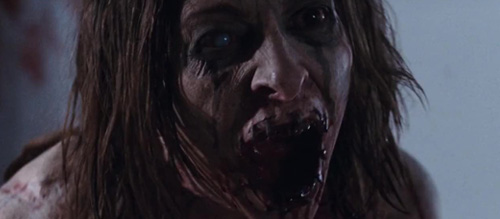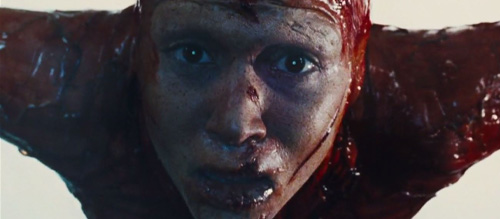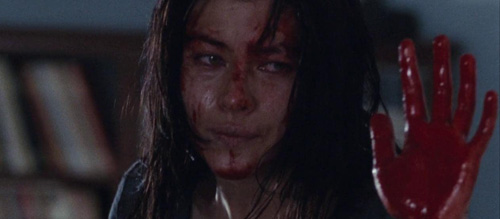Martyrs (2008) Review
Martyrs (2008)
Director: Pascal Laugier
Screenwriter: Pascal Laugier
Starring: Mylène Jampanoï, Morjana Alaoui, Catherine Bégin, Patricia Tulasne, Robert Toupin
To equip a film with repulsive viscera that gushes within its own fleshy and bulbous expositions, wallowing in the sheer cruelty of it all can only be described as barbaric filmmaking that would surely not result in a quintessential piece of genre cinema. Nevertheless, Pascal Laugier’s Martyrs (2008) dares to tread through this contentious territory of moral dilemmas, taboos, and a vicious unease resulting from the innate psychological need to explore pending fates. Martyrs entwines a horrific story so densely impactful that the flagrantly vile imagery and screams of terror are mercilessly clawed onto your mind for long after watching.
Martyrs chronicles the vengeance of Lucie (Mylène Jampanoï) as she vows to destroy those who kept her captive and chained up in a cold, dark warehouse when she was younger. Joining Lucie is Anna (Morjana Alaoui), whom she met during her stay at an orphanage after escaping from the hellish abyss she was held in. After Lucie invades the quaint family home of the Belfonds (her abductors) and commences her slaughter, transforming the occupancy into a bloody abattoir, she discovers that the path to salvation is far from over. The aftermath leaves Lucie a wreck, relying on Anna who hastily rushes over to comfort Lucie in her time of need. Further obstructing their redemption is the ominous secret that Anna unearths: the Belfonds belong to an elitist cult whose mission is to capture young women in a bid to uncover the truth of the afterlife by enacting grossly excessive pain on their subjects until they reach martyrdom status.
The spiteful tone in which extreme cinema is denoted is not only sternly cruel but also rather blemishing to the initial demand for such films as well as the subsequent reception towards the work. The ‘torture-porn’ strain of horror that forcibly infiltrated the market during the mid-2000s has held the disgruntled weight of critical dismay ever since its beginning, with the masses questioning the genre’s need for exploitation in the first place. In opposition to the supposed threat that these films pertain, it could be said that the gory breed of slashers, home invasion feats, and torturous deeds can be seen as a tactical response to the audience’s increasingly hard-to-crack demeanour, primarily in ode to the unavoidable tragedies that the media would widely blast over every news front citing the cataclysmic likes of 9/11, deadly recessions, and the Iraq War. Film has a way of replicating reality in a dramatised form, embodying the socio-political landscape to infiltrate true fears that are masked as monsters and unknown intruders. In other words, theatrical trauma is simply a constructed illusion of the real societal collapses that burden the everyday home and desensitise individuals to the point of no return.
For decades French horror cinema has stuck by the notion that life imitates art. The Nouvelle Vague movement engaged with the societal upholds at the time through the likes of Jean-Luc Godard’s Breathless (1960). Following from this it became common for French cinema to commonly adopt melodramatic tones that still conveyed an air of moral criticism, with L’humanité (1999) – a film handling the aftermath of a sexual assault against a minor – gaining an important place in cinematic history.
When American film dismantled the mainstream with Saw (2004) and Hostel (2005), it became popular to label these films as ‘torture-porn’, demoting them as sadistic filth. The successful chokehold that these graphic features had over audiences flew internationally, popularising France’s already long-established history with disturbing cinema. New French Extremity saw a resurgence and newfound demand that had previously been denied to the subgenre’s earlier works, including the sexually violent Baise-Moi (2000) and the self-cannibalistic tale within In My Skin (2002). As seen, filmmaking is majorly influenced by its want to respond and commentate. One of Laugier’s inspiration points originates from the influx of brutal violence seen in these torture-porn horror spectacles. However, where Martyrs differs and ultimately succeeds is due to Laugier’s self-proclaimed goal of wanting to make a film not surrounding torture itself, but instead a feature focusing on pain and consequential suffering.
Martyrs mobilises our sense of hope from the very first action scene. Minutes into the film, the Belfonds family is introduced in their full nuclear form with a fresh breakfast on display to match the tranquil bourgeois environment where neither money issues nor inner fragilities exist. That is until a knock at the door brutishly shatters the peace. Lucie, armed and loaded, aims at the father’s chest, blowing him back into the staircase, causing a great deal of blood and innards to paint the walls, leaving his now petrified family to run screaming for their lives before Lucie puts each member down with growing severity. After Lucie’s long awaited retribution has ended, she is still haunted by her former demons. Laugier diligently propels the camera around as we witness what has been haunting Lucie this whole time. When she escaped the grip of the Belfonds all those years ago she left a fellow captive in their hold, and ever since then she has been chased by her own mind, manifesting this malformed zombie out of her guilt. The creature tracks her every step, crawling around unclothed and painted with gaping wounds and bloodied limbs. The crutches of torment that Martyrs explores transpires on multiple levels, both in the physical realm of Lucie seeking her revenge and through the various appearances of this creature replicating the entrenched trauma that she will never be able to escape from.

Martyrs appeases on a double-edged sword, meaning that the collaborative prongs that Laugier exposes allow for a quasi-horror tale. The perceived ending is at the 45-minute mark where Lucie’s battle with the scarred demon results in her making a fatal decision, leaving Anna even more alone in the bloodbath. Lucie’s demise, although visually exterior, is very much an inner struggle all engrained in her mind, with every slash the monster dishes out actually being self-inflicted with the embodied figure of guilt only being animated in Lucie’s brittle subconscious. Laugier’s brazen decision to include a manifested titan as a shock-triggering tool may seem rather archetypal to a horror story, but it could be argued that the almost gimmicky placement of a screeching force that grants plenty of loud jump scares is a methodical notch in Laugier’s grand plan to fool each of us, and to make the true nature of the film even more of a surprise.
Deriving from the close bond that eventually ends in tragedy for all parties is the film’s complex myriad that utilises a bold score that plunges heavy rock music over the quick-cut editing and fast-paced combat scenes where every loud strum of the guitar is akin to a blow to the face. Marrying the strategic score symphonies is the demanding camera that refuses to stop fidgeting for the first and second act, continuously bouncing around in an agitated manner leaving no time to relax or to divert the eyes from the sheer terror for just a single second. All of the pungent content, whether that be the stingingly hectic cinematography or the nail-bitingly tense soundscape, is deliberately nihilistic.
Martyrs is a bi-directional piece that both equally surveys the hard price that comes with true bodily emancipation, as well as the hopelessness that trauma provides: no amount of revenge, nor chance of survival equates to happiness in this situation. Candidly, Martyrs depresses, leaving a bleak existence in its wake that interferes with the barest emotions. An aspect that enhances the film’s gut-wrenching existentialism is the ambiguous third act that shifts the straight paradigm that Laugier spent all that time building up to. The apex of suffering initially derived from the unblushing attempts to completely dismantle any emotional stability that we had before watching, is utterly destroyed as the various facets of gore and wounded characters demolish all hope. The constant devastating blows are enough to shield any forms of light from seeping in, yet Laugier dives in further, exploiting the term ‘showing not telling’ to its fullest potential.

When the conclusion breaks and the martyrdom-obsessed cult manifest their full villainous stride, Laugier refuses to simply linger the camera. In avoidance of duplicating similar works of French Extremism such as Irreversible (2002) where Gaspar Noé now holds the camera still for an excruciating nine minutes during one of cinema’s most horrific assault scenes, Laugier floats the camera around, abusing the effects of unbearable closeups. He pans over the treacherous landscape that Anna now knows as home, showing the blood-stained mattress abandoned on the floor, her chopped-off hair and the skin around her lips completely torn and cut. Martyrs certainly aims to displease for every second the film screens.
The continuation of the film is just as, if not more, sombre than the beginning. The violent tendencies of the cult are falsely pursued under a behemoth of wishes, to force their victims to go through so much duress that they remain barely alive in a chance to learn of the afterlife. The neurological displacement of sense is further implied when the group seems to see Anna (and most likely their previous victims) as almost saintly, providing them with their one hope and wish for the good of their souls – whereas in reality, the sufferer has no choice but to comply. It’s this wanton of callousness under the guise of scientific discovery that only adds to the overall piercing tone of the film. These morbid ‘researchers’, for lack of a better term, appear to obtain all of the characteristics that stereotypically paint a pleasant picture to the outside world: they are wealthy, in families (not lone wolves), and they inhabit gorgeous houses with lush surrounding lands. The threatening perspective from an outside point is null and void, masking their seedy underbelly of draconian cruelty.
This clarity of trust is what makes Martyrs so intrepid in wanting us to feel sullied after watching. Anna’s caring nature unintentionally results in her failing. She rushed to the home to help Lucie clean up a crime scene, and then nurses Lucie’s wounds and comforts her even though Anna was uncertain about the accuracy of Lucie’s captors. And in the end, her goodwill is all for nothing, cementing that a person could uphold every contingency of a good person but still be as ill-omened as the rest of them.
Even within the film’s heartbreaking conclusion, Laugier refuses to give a clarifying ending, opting for ambiguity over transparency. The violence and chaotic gore are not cathartic, sensing our inherently dark need for sinister actions to be almost pleasing to some form of inner Freudian-like desires. The lack of titillation bites back and asks us why we would want to continue watching throughout all the dismal displays of pure pain. Martyrs can never be defined as an easy watch. And, throughout the morally twisted leaps and bounds, Laugier still has us held in a tight engrossed grip.
Score: 20/24
Written by Grace Britten
You can support Grace Britten in the following places:
Blog – Film9Online
Instagram – @film_overload_


